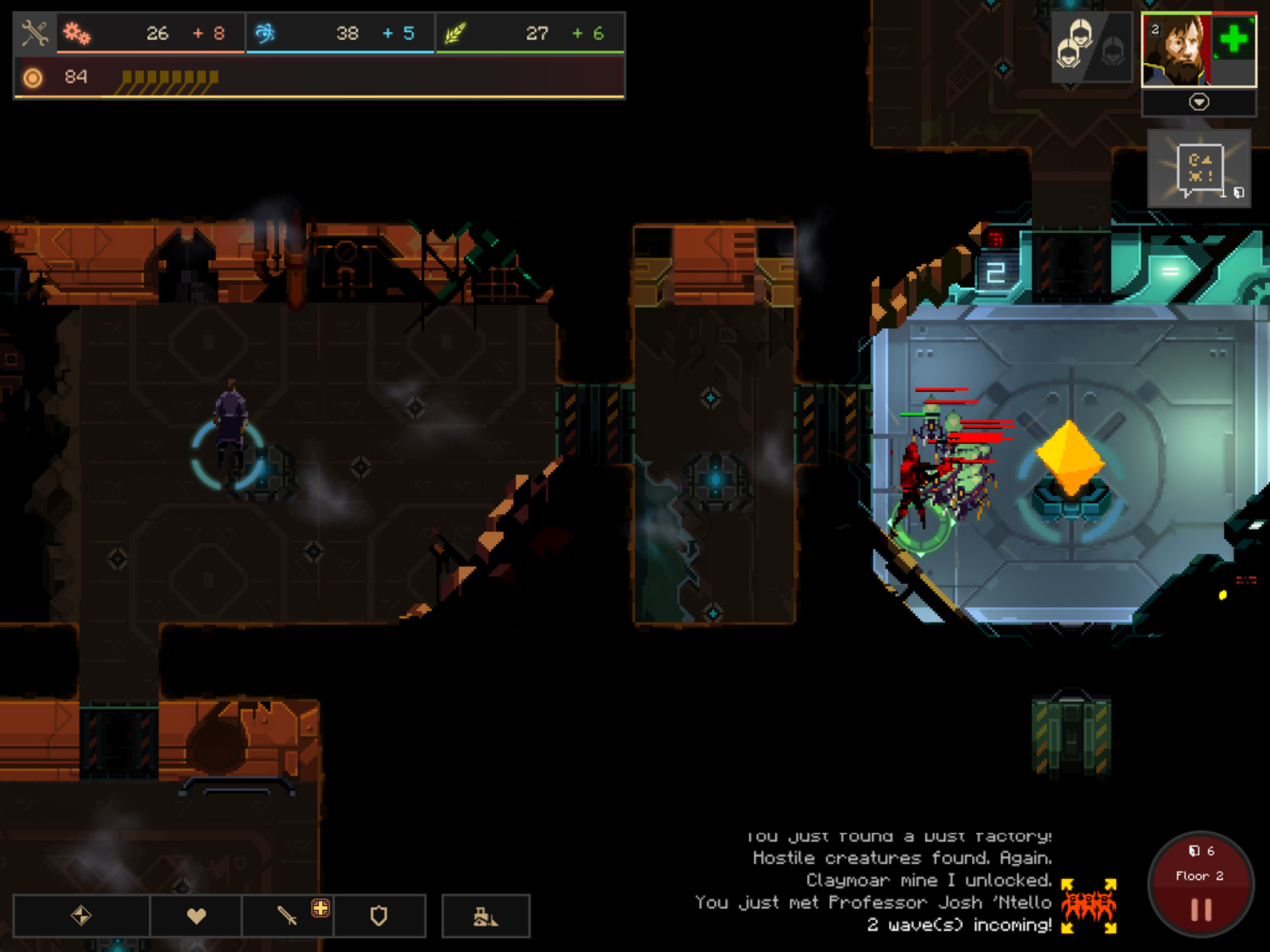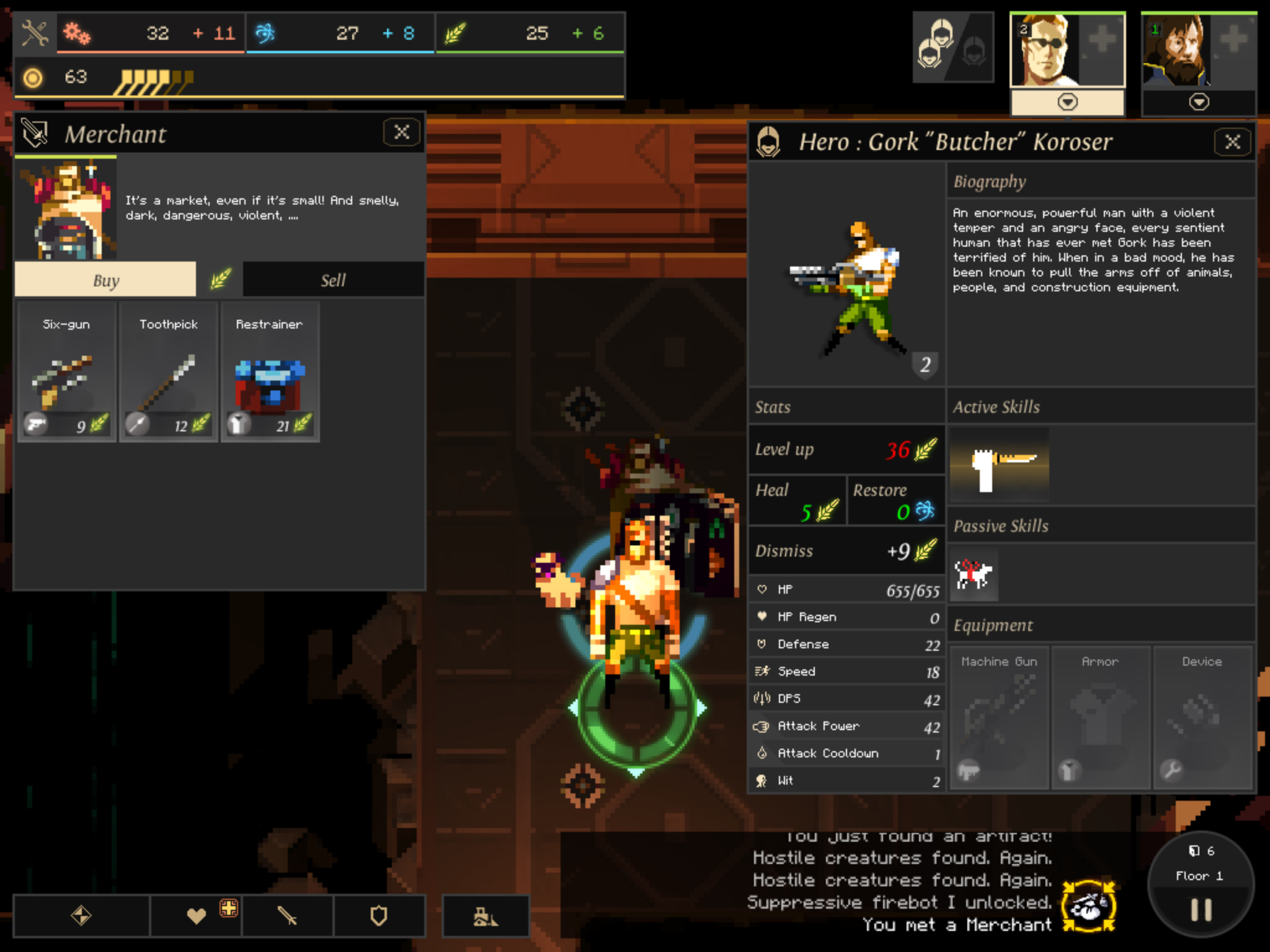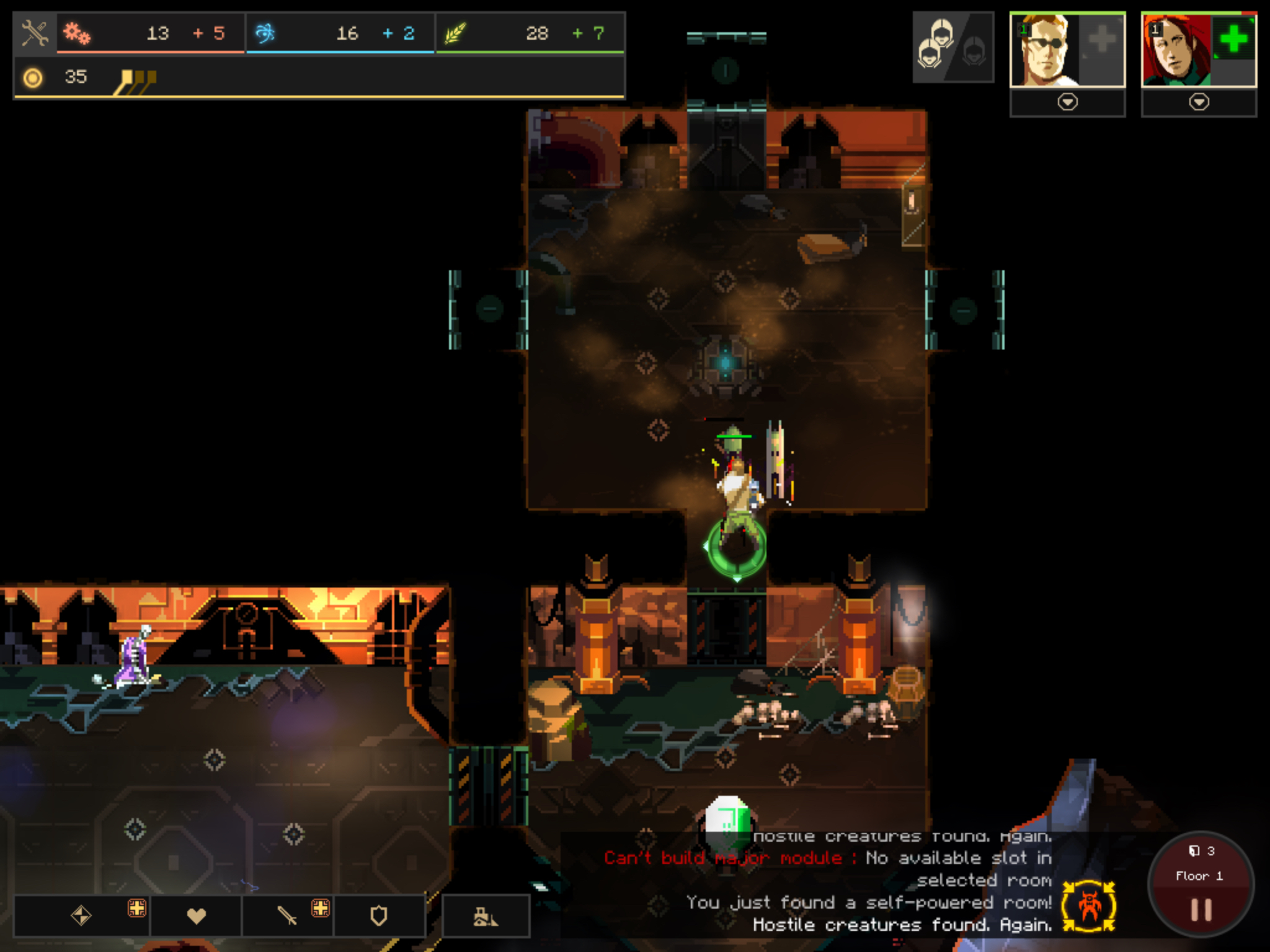 Dungeon Of the Endless ($3.99) is an odd hybrid. On each level, you’ll take your chosen heroes through a room-by-room search, looking for the exit. The layouts are random, so you’ll never know what’s behind each door until you open it. Sometimes you’ll find a merchant who will sell you new gear, other times you’ll find a room full of alien creatures ready to feast on your bones. For this part of the level, you’re essentially going through the roguelike motions, trying to power up your characters and gather resources without pushing yourself too far and getting killed. Once you find the exit, there’s a little twist. You’ll need to go back to the starting room, pick up the heavy crystal contained within, and slowly carry it to the exit while constant attacks are rained down on you. You’ll need to prepare ahead of time by spending resources on turrets and other such defenses, essentially setting up as though you’re playing a tower defense game. Mixing genres is sometimes a recipe for disaster, but Dungeon Of The Endless manages itself quite well.
Dungeon Of the Endless ($3.99) is an odd hybrid. On each level, you’ll take your chosen heroes through a room-by-room search, looking for the exit. The layouts are random, so you’ll never know what’s behind each door until you open it. Sometimes you’ll find a merchant who will sell you new gear, other times you’ll find a room full of alien creatures ready to feast on your bones. For this part of the level, you’re essentially going through the roguelike motions, trying to power up your characters and gather resources without pushing yourself too far and getting killed. Once you find the exit, there’s a little twist. You’ll need to go back to the starting room, pick up the heavy crystal contained within, and slowly carry it to the exit while constant attacks are rained down on you. You’ll need to prepare ahead of time by spending resources on turrets and other such defenses, essentially setting up as though you’re playing a tower defense game. Mixing genres is sometimes a recipe for disaster, but Dungeon Of The Endless manages itself quite well.

That’s not to say it has broad appeal. In fact, I’ll go so far as to say that if you don’t at least like both roguelikes and tower defense, you probably won’t get on with what Dungeon Of The Endless is offering. But it is very thoughtfully designed, and as a result it carries most of the strong points of each genre. The excitement that comes from risky exploration. Finding the exit and wrestling with the decision to keep checking rooms for more goodies or to make good your escape with your life intact. The thrill of finding a powerful piece of gear. Trying to figure out the best plan to protect your crystal and your eventual route to the exit with limited resources. The tension of the run to the exit, trying to hold things together under a relentless assault. This is a game that demonstrates a careful understanding of every element it’s using, putting them together in a way to keep the player on their toes and powerfully engaged.
The game starts by having you choose your heroes from an eventual roster of 19 suspiciously-familiar faces, along with the ship you’d like to explore. In the beginning, your options are limited to six heroes and a single ship, with more content unlocking as you complete certain challenges. Each hero has their own specific skills and stats, and the different ships will impose various bonuses and penalties. You can pick two heroes to start with, so you’ll want to think carefully about how they can complement each other’s abilities. For example, Not-Arnie is a powerful attacker, but he moves incredibly slowly. He’s great for opening new doors or guarding a particular location, but when it comes time to make a run for the exit, he’s not very helpful. Not-Samus, on the other hand, is speedy and reasonably good at fighting, but a bit fragile. Great for when you want to close distances, but she can be easily overwhelmed if too many enemies attack at once. Each hero also has a special skill they can use now and then. The cooldown timer on it is connected to how many doors you’ve opened, so you’ll have to keep pushing forward if you want to use your skills regularly.

The rudimentary tutorial doesn’t explain the game’s mechanics very well, but it will at least give you a push. Your basic goal is to find the exit somewhere in the level, then bring your precious power crystal to it in order to move on to the next level. You can’t take your crystal until you find the exit. Until then, it sits somewhat vulnerably in the room you started in. Enemies will attack it if they can, and if they destroy it, you’re through. Opening doors will earn you resources of various types. Dust is used to power everything, and serves as the lifeblood of your crystal. You’ll also collect three other types of resources, used to build facilities, research technology, or level-up/ heal your heroes. Building a facility in a room will light it up, preventing enemies from spawning inside of it. Unfortunately, you’ll never have enough resources to light all, or even most, rooms, so you need to think carefully about which ones serve your strategic needs, both for the exploration phase and the eventual evacuation.
These mechanics force you to make a lot of interesting choices. Do you want to use your food to heal your characters, or save it for leveling up? Spend machinery points on traps or building facilities? If you find a new piece of gear, will you equip it now and risk losing it, or bank it for the next floor? None of these situations offer clearly correct answers. The right answer might see you through to the next floor, but maybe not. Success requires you to put together a careful plan, survive long enough to gather the resources to carry it out, and then pull it off without anything going wrong. Even getting past the first floor on the normal difficulty setting, named “easy" here, is a pretty big difficulty hump. If you can come to grips with the game well enough to manage that little task, you’ll find things are a lot easier, even as they become more difficult. I recommend swallowing your pride and choosing the lower difficulty setting until you get the hang of things.

Once you get into the flow of the game, it’s a lot of fun. There are plenty of interesting unlockables that you’ll earn as rewards for reaching new heights, giving you a reason to push yourself beyond simply trying to beat your best score. Importantly, these unlockable characters and ships don’t so much offer clear advantages as they offer you different ways to play. There’s a lot here for the long-term player to chew on. The gameplay runs deep, more than I can really fully explain in even this size of a review, and while that’s a good thing, it means you’re going to have to give the game a lot of focused attention. One thing that will help you stick around during the learning phase is the gorgeous presentation. The visuals and sounds work well to establish the mood and setting of the game’s world. You can feel the influence from the Alien movies and Metroid, with a spooky, isolated atmosphere that makes opening doors feel a little tense each time. Darkness is firmly established as the enemy, and every time you’re able to light up a room, there’s a tangible feeling of relief.
Aside from not explaining itself terribly well, my biggest gripe with the game stems from the controls. They’re not bad, but they are unusual in some ways, and it can be fatally awkward trying to get specific characters to do what you need them to do in a pinch. You can’t just tap on rooms and expect characters to go there. You’ll have to find some kind of point inside the room to tap. And juggling multiple characters when the action heats up can be difficult, since you have to have at least one character selected at any time. Moving another character separately requires that you tap on the character you want to use, then tap on your original character to de-select them. You have the option to pause the game while giving out orders, and I recommend you use that feature a lot. I suppose I’m also not a fan of the fact that the suspend save resumes your game at the beginning of the floor you left off on as opposed to your exact place on the floor. Sure, you can use it to your advantage if things go awry, but I’d rather have a better save system for when my play gets interrupted by real life.
Still, individual floors don’t take that long to finish in their entirety, and you’ll probably adjust to the quirky controls in time. That’s really what Dungeon Of The Endless comes down to: time. It’s a matter of how much time you’re willing to invest in the game in order to get the most out of it. There are a lot of great roguelikes and tower defense games on iOS that offer up nearly-instant rewards, but that’s not the way this particular game is set up. Its bizarre genre-crossing means that you’re going to have to learn a lot of new things, even if you’ve played plenty of games that share certain elements with it. That aspect is going to turn off some, while sounding like sweet music to others. One thing is for sure, however. If you’ve been looking for a deeper experience in either genre, you’ll want to find a home for this game on your iPad.